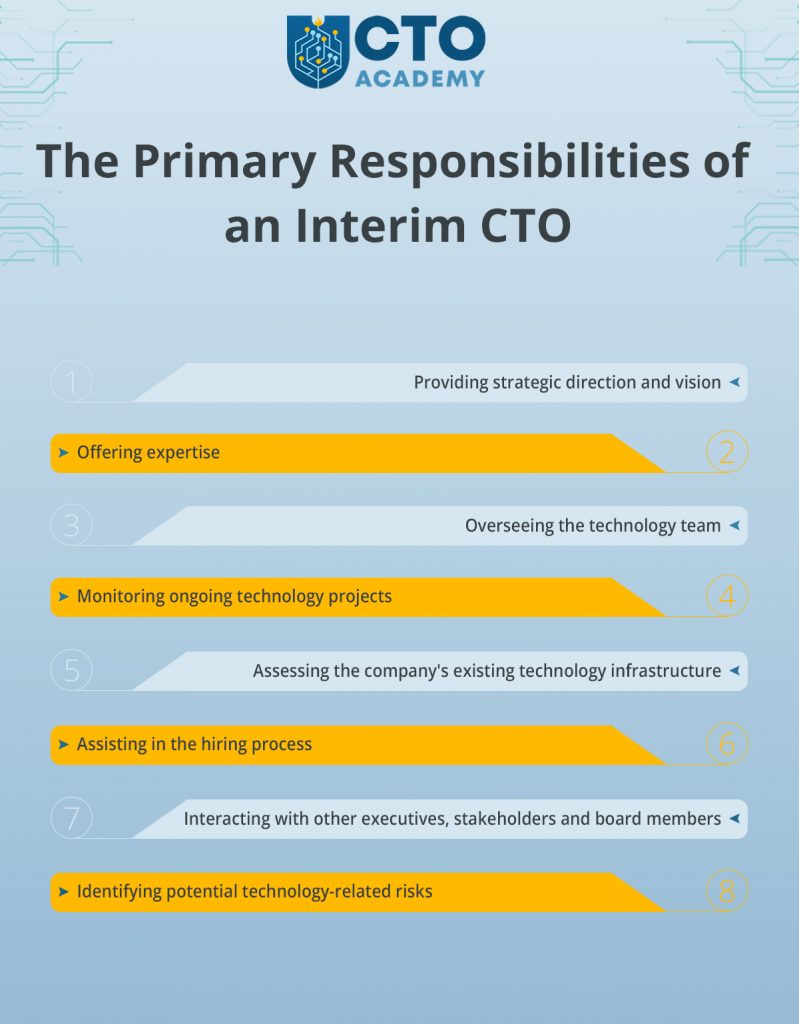An Interim CTO is a temporary executive responsible for overseeing and guiding the company’s technology strategy and operations during a transitional period. Companies hire interim CTOs on a short-term basis, either due to a sudden departure of the previous CTO, a planned leadership change or while searching for a full-time CTO.
(Don’t mistake an Interim Chief Technology Officer for a Fractional CTO. A Fractional CTO works for a fraction of the time and cost and just on the part of the project. In other words, they work side by side with the in-house CTO to assist on certain projects or their fractions.)

Interim CTOs must, therefore, possess extensive experience in technology leadership roles and have all the necessary skills to step into the position quickly and effectively. Their role is vital in maintaining continuity and ensuring the organisation’s technology operations run smoothly while the company searches for a suitable permanent chief technology officer.

Step #1: Pre-onboarding preparation
Before the Interim CTO starts their role, HR and the hiring manager coordinate to ensure all necessary paperwork, contracts and confidentiality agreements are in place.
IT and facilities teams set up the Interim CTO’s workspace, providing them with the necessary tools, equipment and access to company systems.
Step #2: Introducing an Interim CTO to key stakeholders
The Interim CTO should be introduced to key stakeholders, including the CEO, executive team, department heads and other relevant personnel. This, subsequently, helps establish rapport, clarify expectations and provide an overview of the organisation’s structure and culture.
Step #3: Technology infrastructure and documentation access
The company enables access to documentation and information related to the technology infrastructure, systems and, more importantly, ongoing projects.
Reviewing this documentation provides insights into the existing technology setup, thus making it possible for a new technology leader to identify potential areas for improvement.
Step #4: Team introductions
The only way to understand the roles, strengths and concerns of the team is to meet them individually. This, in turn, builds a positive working relationship which is essential for collaboration and effective leadership.
Step #5: Understanding current projects and initiatives
The company briefs the new CTO on all ongoing technology projects and initiatives. These briefs must include objectives, progress and challenges. This will allow a newly appointed interim executive to align the efforts with immediate goals.
Step #6: Assessment of technology processes
The ICTO must assess existing technology processes and workflows to identify any bottlenecks or inefficiencies. This is a prerequisite for the formulation of strategies for streamlining operations.
Step #7: Identifying key issues and risks
Companies often seek a remote interim CTO when they require a technology expert to swiftly stabilise their technological environment.
To achieve that goal, the temporary chief technology officer will work closely with the team to identify critical technology issues, security risks or compliance concerns requiring immediate attention.
Step #8: Goal setting and strategy formulation
The goals and strategy formulation are based on the organisation’s objectives and challenges. This, of course, requires close collaboration with the executive team because the strategy must align with the company’s overall business objectives.
Step #9: Development of the communication plan
The aim here is to develop a practical communication plan to ensure regular updates with the CEO, the rest of the executive team and other stakeholders. This can be done by the newly appointed temporary CTO alone or as a collaboration between all stakeholders.
Step #10: Performance metrics and reporting
Fast-growth companies may lack the necessary experience in tracking performance or setting up the metrics for this particular position.
Always keep in mind that, in some instances, the fast-growing company was a startup only a few months ago.
Hence, it’s a CTO’s job to work with an organisation to define performance metrics and reporting requirements; otherwise, it would be virtually impossible for the organisation to track progress and, most importantly, measure the impact of technology initiatives.
Step #11: Regular review meetings
To effectively define and tackle challenges, it is essential to regularly convene with the team and engage in discussions regarding their progress.
Step #12: Knowledge transfer plan (if applicable)
If there is a plan to hire a permanent CTO, a knowledge transfer plan must be implemented to facilitate a smooth transition.
To sum up, the onboarding process should be structured, comprehensive and, more importantly, focused on aligning the individual with the organisation’s goals while addressing immediate technology challenges.
No company is perfect and people and process issues will arise from this onboarding. The interim CTO will have to decide, if and when, to resolve these issues and, at least, highlight them to the CEO.
The duration can vary depending on:
On average, an Interim CTO position can last anywhere from 6 to 12 months in such companies. But this is relative and depends on a series of factors such as:
As you can see, the actual duration of the interim contract depends on the unique circumstances and requirements of an organisation. Additionally, it may easily evolve into a permanent position.
But if that doesn’t happen, there’s one further instance you must prepare for.
Knowledge Transfer and Documentation
It is in your best interest to jump-start the new CTO, so to speak, because word travels fast and covers long distances—both good and bad.
Therefore:
Status and Project Updates
Team Introductions and Transition
Stakeholder Engagement
Understanding the expectations and priorities of various stakeholders will help the new CTO align technology strategies with overall business goals – just as it helped you.
Establishing Relationships and Communication Channels
Handover of Responsibilities
Support and Availability
This type of support has proved itself instrumental in addressing unexpected challenges and fostering a successful transition.
Assessment and Feedback
90 Things You Need To Know To Become an Effective CTO

London
2nd Floor, 20 St Thomas St, SE1 9RS
Copyright © 2024 - CTO Academy Ltd